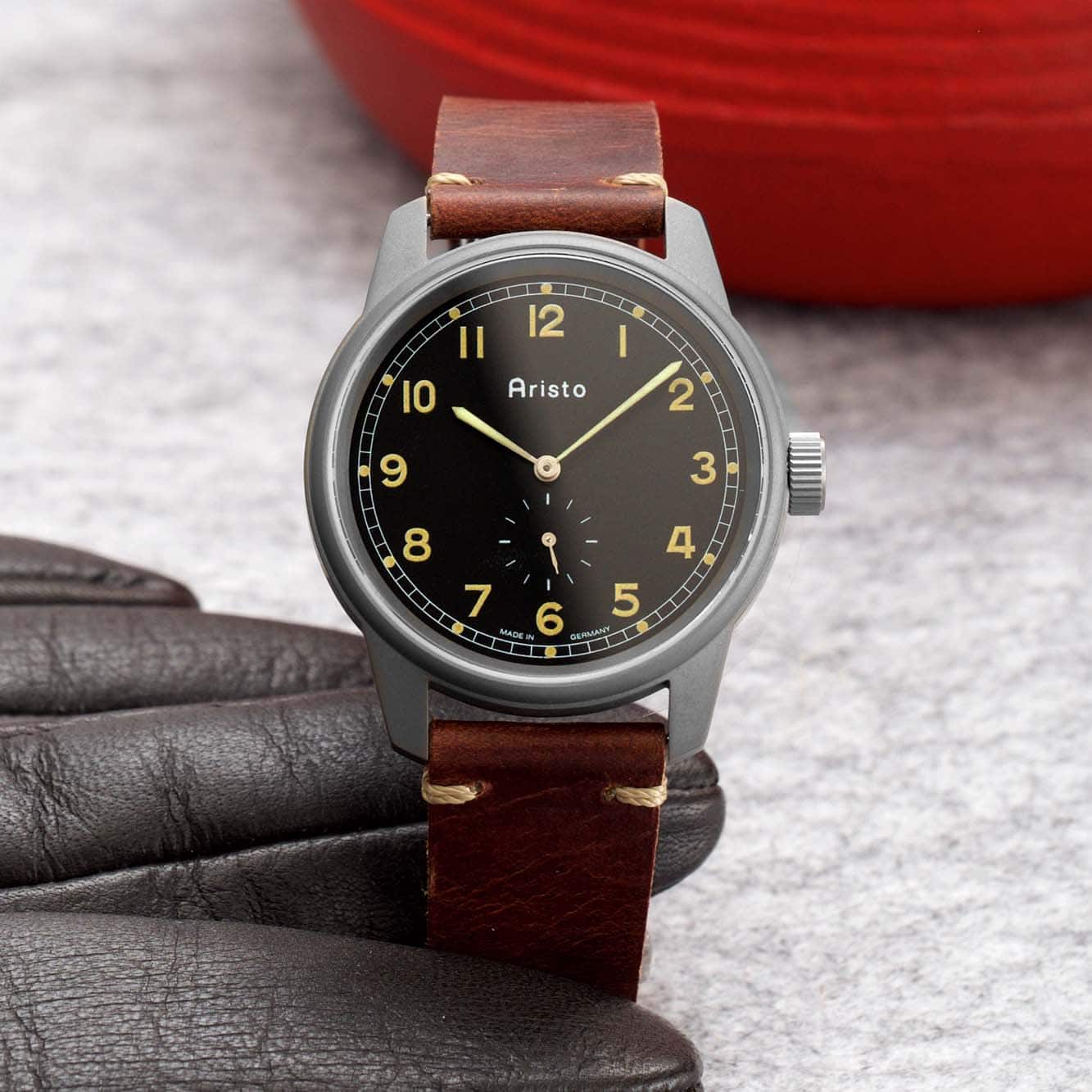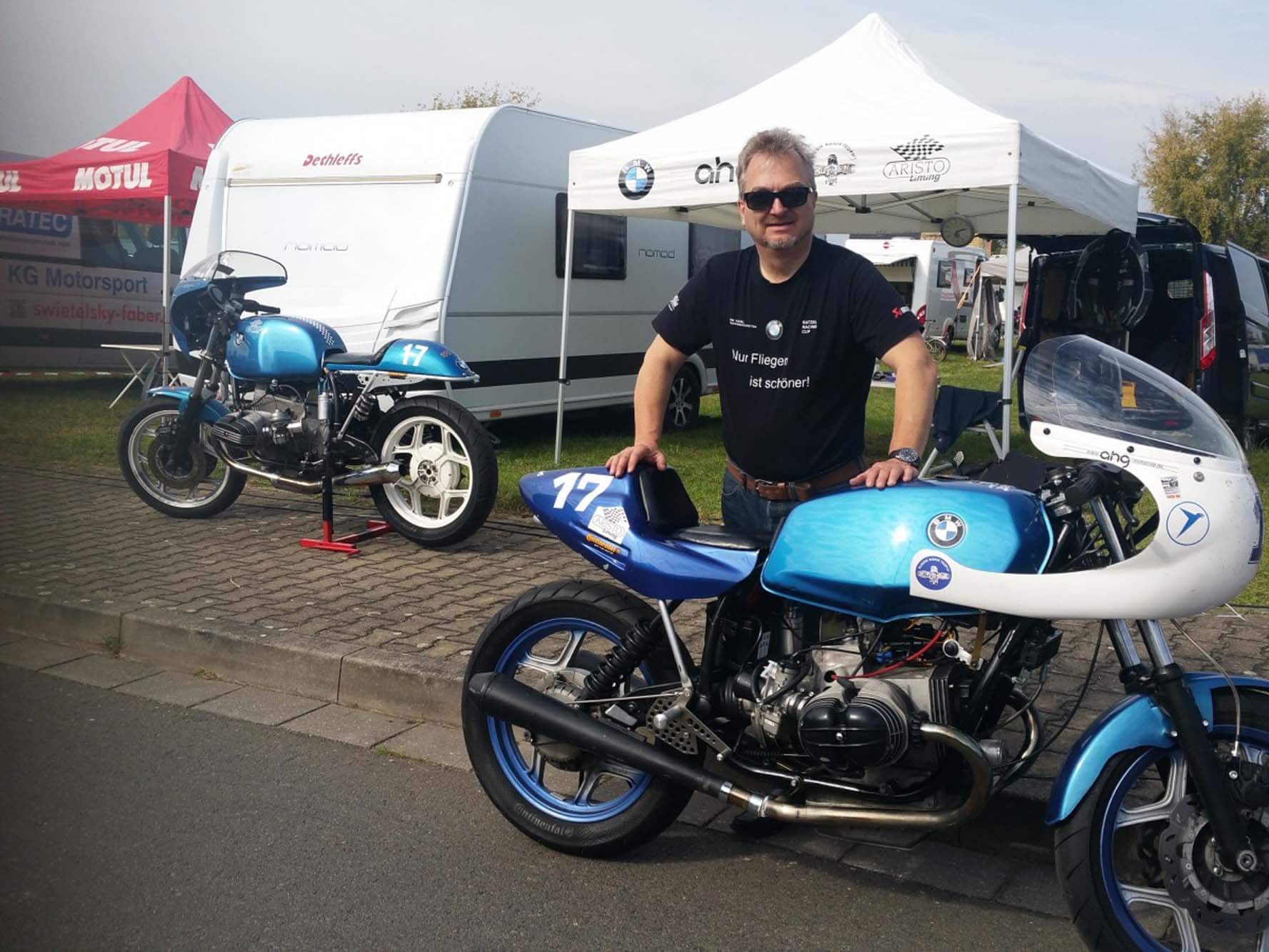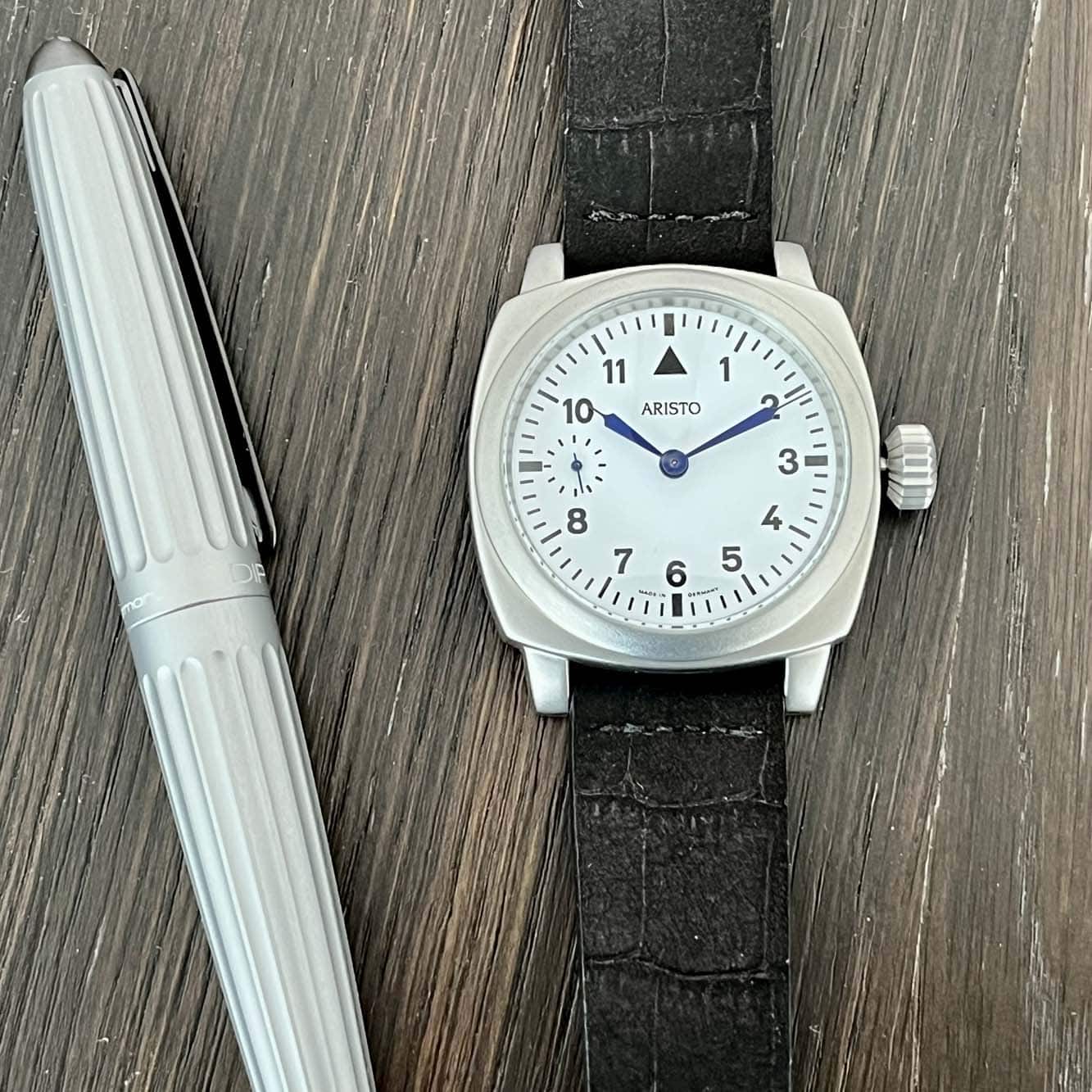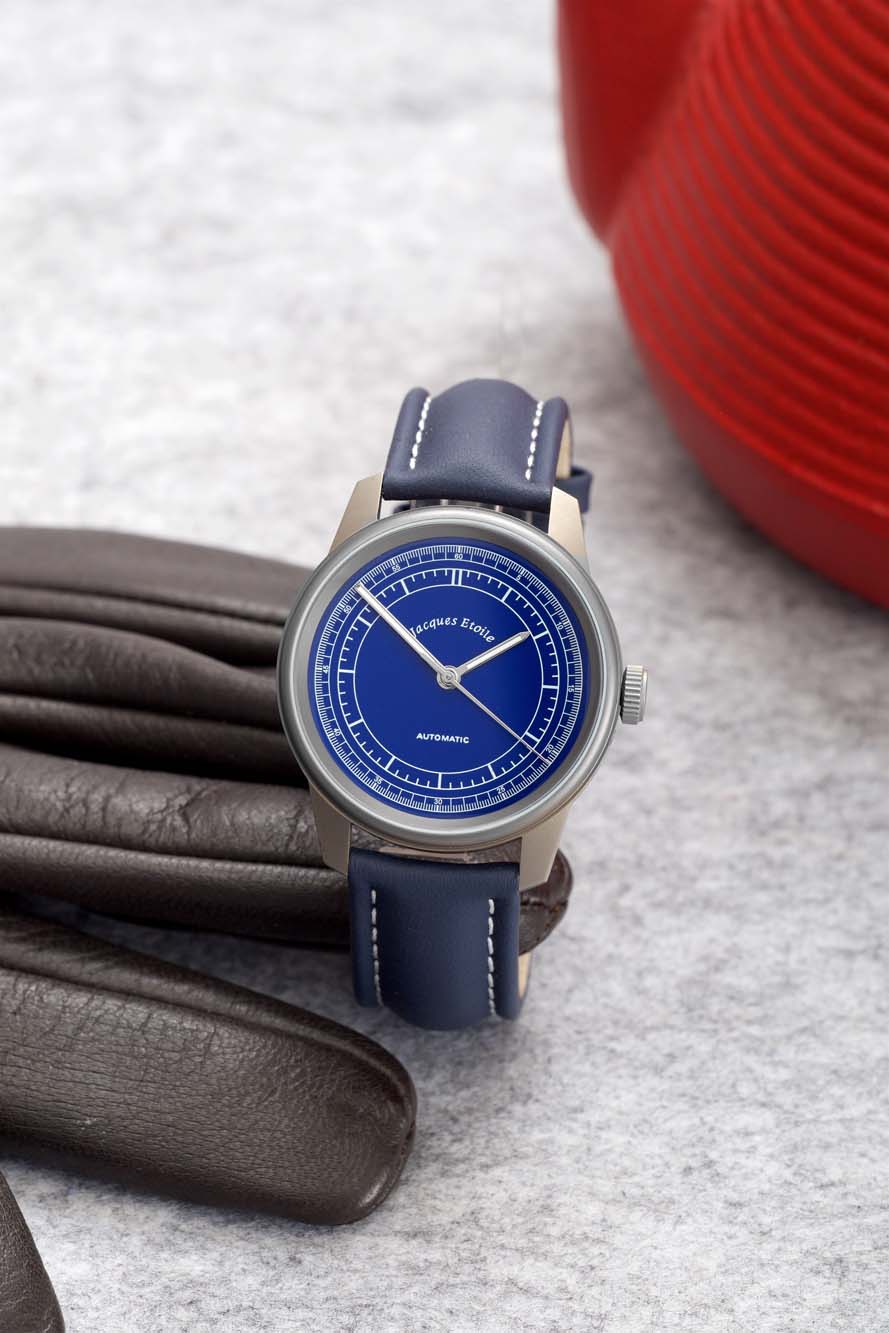I recently visited the Aristo Vollmer watch and bracelet manufacturer in the Black Forest town of Pforzheim. Aristo-Vollmer was founded 14 years ago as a merger of two well-known companies from the towns of Birkenfeld and Pforzheim.
After three generations in the possession of the founding Epple family, the watch manufacturer Aristo Watch was sold in 1998 to Hansjörg Vollmer, a member of the founding family of watch bracelet manufacturer Vollmer, which has been associated with Aristo since 1927.
Hansjörg Vollmer is a grandson of the founder of the metal bracelet manufactory Vollmer (Vollmer, Evvo, New Line), which was founded in 1922 and had maintained business relations with Aristo since 1927. After World War II, the production of bracelets moved from Birkenfeld to Pforzheim where it is still located next to the Pforzheim train station.
Since 2005, the Aristo-Vollmer’s portfolio includes watch brands (Aristo, Aristomatic, Aristocrat, Messerschmitt, Vollmer, Bellana, Aristella, and Erbprinz) as well as bracelets (stainless steel, titanium, carbon), buckles, and deployant clasps. The bracelets are used for its own watch brands, and supplied to retailers, as well as outside the group. Recently Aristo added Klaus Jakob’s Jacques Etoile brand, which we’ll come back to a little later.
Hansjörg is an intriguing personality, very driven yet approachable. He is a high-speed fanatic and professionally races BMW motorcycles, and even custom builds them upon request. I attended one of his races in the Czech Republic and was impressed that at age 65, he was convincingly beating riders in their 20s. He has a long lineup of trophies in the factory. His vacations and business trips incorporate his racing schedule and lifestyle. He works a lot with carbon fiber for his bikes, so it was natural for him to use it in watches as well.
In 2004, Aristo, with the model 3H45, pioneered a carbon watch with a carbon dial. A year later, Aristo introduced its new model “Carbon II” at Baselworld 2005. In 2006, the Carbon chronograph was introduced with a stainless steel case treated with PVD. I remember Hansjörg showing me these watches enthusiastically in Basel with pictures of his motorcycles.
From 2010 to 2012 Aristo participated in a technology program supported by the German Ministry of Economic Affairs and Research. Since then, composite constructions of bracelets (for watches and jewelry) made of carbon, in combination with stainless steel or titanium links, are being mass produced. Due to the resistance, lightweight, and the allergy-neutral properties of this material compared to steel, Aristo has extended their carbon portfolio.
Walking into the Aristo factory is like a walk into the past of Pforzheim watchmaking. Everything appears to be left intact from decades of manufacturing and likely by a much larger workforce. Since the Vollmer factory resided a few kilometers outside of Pforzheim, they were spared by the Allied bombs in the war years. Hence, the moment you enter the workshop, you can immediately smell the oil from the machines and see them in action – it’s like taking a time machine to the early 1940s. A couple of watch friends who joined me on this trip glanced at each other in disbelief, but with a big grin, knowing that we were experiencing something special. We are so accustomed to seeing modern production with all the DIN certifications, but this was like the Willy Wonka factory with fully functioning vintage fuse boxes and hand-and-foot operated machines.
After the workshop floors, we visited this small archive room which is used as a “museum”, and we found a treasure trove of old dials with a very interesting history. As some Stowa aficionados already know there was a dial making company located in Pforzheim in the 1930s and 1940s, known as Weber & Baral. A lot of new brands took up an old design of 1937 Weber & Baral dials which were – for example – used by Lange & Söhne and Stowa in those days. To our surprise, we found two samples of these old Weber & Barals dials in the archives. Nowadays you will see that this design is mostly used by Nomos (Tangente) and Stowa (Antea).
We then discovered a huge box of samples of rectangular cases Aristo made during that same time period – all of them had their original tags. There was also a sample book with hand-drawn pendants for pocket watches. You do not come across this old stuff often.
As we sifted through all the historical dials, cases, bracelets, and watches, there was this one watch which caught my eye – the Aristo Bundeswehr chronograph made in co-operation with Helmut Sinn. Aristo had made two dial variations in white/cream and black and cased it in the 1970’s Sinn 144 steel case with reference 3H19xx. There were a few variations of the Tachymeter and other scales inside the bezel as well. The watch is powered by Valjoux 7750 and has a German day wheel with date. This specific example had the Vollmer mesh bracelet. There are other known examples in Aristo’s catalog from the early 2000s, which came with a Bund leather strap.
Another watch I came across was a neo-vintage Flieger style white dial in a cushion case with a massive crown. As a Flieger enthusiast, this was an unusual and intriguing watch. Hansjörg explained that Aristo over the years collaborated with other brands, purchasing their dials and movements. This Flieger had a special and well-decorated Molnija movement. Molnija movements are still produced in Russia and started out as a copy of a Swiss Cortébert movement. This movement was custom made for Aristo and is nicely decorated upon Hansjörg’s request.
As we sat down in Hansjörg’s office to see the entire collection, my first impression was not as enthusiastic. My pet peeve is the placement of tiny date at 3 o’clock, when either a proper date window or no date at all is a better option. Most of the watches I saw as I looked around had this tiny date. When I started to pick up watches from each collection, it started to make more sense. I realized that Aristo has their normal retail stores, mid-to-low priced offerings, and then they have special pieces that watch enthusiasts and collectors would appreciate.
The Messerschmitt collection had some interesting pilots style watches, even though most of these again had the small date. Some models did resonate with me, like the oversized Aristo ME-262, which has the dial made from the chassis sheet of the original ME-262 aircraft. It is something the “old” Bremont would have done.
However, the watches that left the strongest impression were the vintage style watches made from either unique dials or movements. The watches Aristo makes using the historical 1970s Longines’ Record 1959-2 automatic movement stand out as a great bargain. Aristo managed to secure several of the unused Record movements. They first disassembled, then completely cleaned and reassembled these movements to ensure proper functionality and accuracy.
I like both the classic dress style watches in a 38.5mm case, and the military style watches in larger cases with the Record movement. These watches feature restrained vintage inspired dials, no date, and run on historical movements, for under $600. Due to the limited stock of the movement, they are limited in numbers per series. If Aristo made the exact same models with Sellita movement for under $500 as part of their permanent collection, I think it would still be a good value proposition.
The Aristo Vintage Pilot Chronograph shares the same design with the classic Porsche Design watch from the 1970s. As noted earlier that Aristo and Helmut Sinn had a friendly relationship and even shared some parts, such as watch cases. In the past, Aristo produced matte, dark sandblasted stainless steel cases in the 40.5mm size. However, these cases have not been used until now. Hansjörg decided to put these cases to use in a Pilot chronograph in limited production (not a limited edition).
The Pilot chronograph is available in two versions – with Arabic numerals, and with hour markers for a clean look. The unidirectional rotating bezel can be turned counterclockwise. The crown protector and chronograph pushbuttons are ergonomically designed and give the Top Gun atmosphere of the 1980s. The watch is completed with a matching mesh bracelet made in the Pforzheim factory, or on a leather strap, which gives the watch a more modern look. Personally, I think the hour marker version on a mesh bracelet makes for an excellent piece. It’s powered by a Sellita SW500 movement and priced at approximately $1,300.
Finally, Hansjörg has taken over the production of Jacques Etoile watches from Klaus Jakob. In the near future, I will do a deeper dive into Klaus Jakob, who is a watchmaker from Lörrach, in southwest Germany. Klaus was essentially making some cool watches at about the same time as Chronoswiss, in the early 2000s. Both of them were known for heavily modifying movements to create interesting complications and designs. During COVID, Klaus entrusted his Jacques Etoile brand to Aristo and now solely focuses on his second brand, Mercure.
The sector dial Jacques Etoile Le Mans series are understated three-hander watches. The dials are available in four colors – blue, salmon, black, and orange. The case size is 41mm in either steel or titanium. It wears more like 40mm, with a 48mm lug to lug measurement. I am slightly biased towards the salmon dial in titanium since it is a unique dial color and combination. It is powered by a Sellita SW200 and priced around $500. These vintage dials are worth the price of the watch. Klaus Jakob was not known to skimp on the quality of the parts. He had his dials manufactured at the well-known Schätzle dial maker in Weil am Rhein, Germany.
Overall, visiting the Aristo factory was like dialing up the time machine back to the better manufacturing days of Pforzheim. I enjoyed looking for hidden gems that can be found in the Aristo collection and in their archives. There are exciting things happening there, and Hansjörg Vollmer is a steady hand guiding the operation. It will not surprise if a decade from now we find Hansjörg still competing professionally with his trusty BMW bike at the ripe age of 75, and winning more races.
The post What I Discovered on My Visit to The Aristo-Vollmer Factory appeared first on Worn & Wound.











